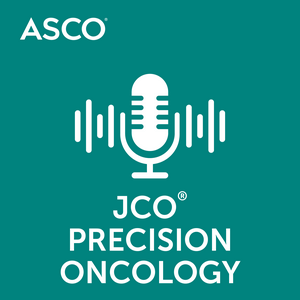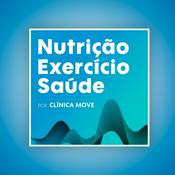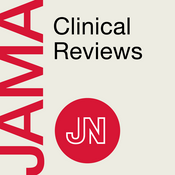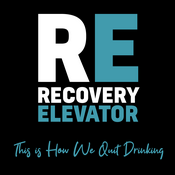JCO Precision Oncology Conversations

61 episódios

Podcast: FGFR3 Alteration Status and Immunotherapy in Urothelial Cancer
17/12/2025 | 18min
JCO PO author Dr. Shilpa Gupta at Cleveland Clinic Children's Hospital shares insights into her article, "Fibroblast Growth Factor Receptor 3 (FGFR3) Alteration Status and Outcomes on Immune Checkpoint Inhibitors (ICPI) in Patients with Metastatic Urothelial Carcinoma". Host Dr. Rafeh Naqash and Dr. Gupta discuss how FGFR3 combined with TMB emerged as a biomarker that may be predictive for response to ICPI in mUC. TRANSCRIPT Dr. Rafeh Naqash: Hello and welcome to JCO Precision Oncology Conversations, where we bring you engaging conversations with authors of clinically relevant and highly significant JCO PO articles. I'm your host, Dr. Rafeh Naqash, podcast editor for JCO Precision Oncology and Associate Professor at the OU Health Stephenson Cancer Center. Today I am excited to be joined by Dr. Shilpa Gupta, Director of Genitourinary Medical Oncology at the Cancer Institute and co-leader of the GU Oncology Program at the Cleveland Clinic, and also lead author of the JCO PO article titled "Fibroblast Growth Factor Receptor 3 Alteration Status and Outcomes on Immune Checkpoint Inhibitors in Patients With Metastatic Urothelial Carcinoma." At the time of this recording, our guest's disclosures will be linked in the transcript. Shilpa, welcome again to the podcast. Thank you for joining us today. Dr. Shilpa Gupta: Thank you, Rafeh. Honor to be here with you again. Dr. Rafeh Naqash: It is nice to connect with you again after two years, approximately. I think we were in our infancy of our JCO PO podcast when we had you first time, and it has been an interesting journey since then. Dr. Shilpa Gupta: Absolutely. Dr. Rafeh Naqash: Well, excited to talk to you about this article that you published. Wanted to first understand what is the genomic landscape of urothelial cancer in general, and why should we be interested in FGFR3 alterations specifically? Dr. Shilpa Gupta: Bladder cancer or urothelial cancer is a very heterogeneous cancer. And while we find there is a lot of mutations can be there, you know, like BRCA1, 2, in HER2, in FGFR, we never really understood what is driving the cancer. Like a lot of old studies with targeted therapies did not really work. For example, we think VEGF can be upregulated, but VEGF inhibitors have not really shown definite promise so far. Now, FGFR3 receptor is the only therapeutic target so far that has an FDA approved therapy for treating metastatic urothelial cancer patients, and erdafitinib was approved in 2019 for patients whose tumors overexpressed FGFR3 mutations, alterations, or fusions. And in the landscape of bladder cancer, it is important because in patients with non-muscle invasive bladder cancer, about 70 to 80% patients can have this FGFR3. But as patients become metastatic, the alterations are seen in, you know, only about 10% of patients. So the clinical trials that got the erdafitinib approved actually used archival tumor from local cancer. So when in the real world, we don't see a lot of patients if we are trying to do metastatic lesion biopsies. And why it is important to know this is because that is the only targeted therapy available for our patients right now. Dr. Rafeh Naqash: Thank you for giving us that overview. Now, on the clinical side, there is obviously some interesting data for FGFR3 on the mutation side and the fusion side. In your clinical practice, do you tend to approach these patients differently when you have a mutation versus when you have a fusion? Dr. Shilpa Gupta: We can use the treatment regardless of that. Dr. Rafeh Naqash: I recently remember I had a patient with lung cancer, squamous lung cancer, who also had a synchronous bladder mass. And the first thought from multiple colleagues was that this is metastatic lung. And interestingly, the liquid biopsy ended up showing an FGFR3-TACC fusion, which we generally don't see in squamous lung cancers. And then eventually, I was able to convince our GU colleagues, urologists, to get a biopsy. They did a transurethral resection of this tumor, ended up being primary urothelial and synchronous lung, which again, going back to the FGFR3 story, I saw in your paper there is a mention of FGFR3-TACC fusions. Anything interesting that you find with these fusions as far as biology or tumor behavior is concerned? Dr. Shilpa Gupta: We found in our paper of all the patients that were sequenced that 20% had the pathognomonic FGFR3 alteration, and the most common were the S249C, and the FGFR3-TACC3 fusion was in 45 patients. And basically I will say that we didn't want to generate too much as to fusion or the differences in that. The key aspect of this paper was that historically there were these anecdotal reports saying that patients who have FGFR alterations or mutations, they may not respond well to checkpoint inhibitors because they have the luminal subtype. And these were backed by some preclinical data and small anecdotal reports. But since then, we have seen that, and that's why a lot of people would say that if somebody's tumor has FGFR3, don't give them immunotherapy, give them erdafitinib first, right? So then we had this Phase 3 trial called the THOR trial, which actually showed that giving erdafitinib before pembrolizumab was not better. That debunked that myth, and we are actually reiterating that because in our work we found that patients who had FGFR3 alterations or fusions, and if they also have TMB-high, they actually respond very well to single agent immunotherapy. And that is, I think, very important because it tells us that we are not really seeing that so-called potential of resistance to immunotherapy in these patients. So to answer your question, yeah, we did see those differences, but I wouldn't say that any one marker is more prominent. Dr. Rafeh Naqash: The analogy is kind of similar to what we see in lung cancer with these mutations called STK11/KEAP1, which are also present in some other tumors. And one of the questions that I don't think has been answered is when you have in lung cancer, if you extrapolate this, where doublet or single agent immunotherapy doesn't do as well in tumors that are STK11 mutated. But then if you have a high TMB, question is does that TMB supersede or trump the actual mutation? Could that be one reason why you see the TMB-high but FGFR3 altered tumors in your dataset responding or having better outcomes to immunotherapy where potentially there is just more neoantigens and that results in a more durable or perhaps better response to checkpoint therapy? Dr. Shilpa Gupta: It could be. But you know, the patients who have FGFR alterations are not that many, right? So we have already seen that just patients with TMB-high respond very well to immunotherapy. Our last podcast was actually on that, regardless of PD-L1 that was a better predictor of response to immunotherapy. So I think it's not clear if this is adding more chances of response or not, because either way they would respond. But what we didn't see, which was good, that if they had FGFR3, it's not really downplaying the fact that they have TMB-high and that patients are not responding to immunotherapy. So we saw that regardless, and that was very reassuring. Dr. Rafeh Naqash: So if tomorrow in your clinic you had an individual with an FGFR3 alteration but TMB-high, I guess one could be comfortable just going ahead with immunotherapy, which is what the THOR trial as you mentioned. Dr. Shilpa Gupta: Yes, absolutely. And you know, when you look at the toxicity profiles of pembrolizumab and erdafitinib, really patients really struggle with using the FGFR3 inhibitors. And of course, if they have to use it, we have to, and we reserve it for patients. But it's not an easy drug to tolerate. Currently the landscape is such that, you know, frontline therapy has now evolved with an ADC and immunotherapy combinations. So really if patients progress and have FGFR3 alterations, we are using erdafitinib. But let's say if there were a situation where a patient has had chemotherapy, no immunotherapy, and they have FGFR3 upregulation and TMB-high, yes, I would be comfortable with using only pembrolizumab. And that really ties well together what we saw in the THOR trial as well. Dr. Rafeh Naqash: Going to the clinical applications, you mentioned a little bit of this in the manuscript, is combination therapies. You alluded to it a second back. Everything tends to get combined with checkpoint therapy these days, as you've seen with the frontline urothelial, pembrolizumab with an ADC. What is the landscape like as far as some of these FGFR alterations are concerned? Is it reasonable to combine some of those drugs with immune checkpoint therapy? And what are some of the toxicity patterns that you've potentially seen in your experience? Dr. Shilpa Gupta: So there was indeed a trial called the NORSE trial. It was a randomized trial but not a comparative cohort, where they looked at FGFR altered patients. And when they combined erdafitinib plus cetrelimab, that did numerically the response rates were much higher than those who got just erdafitinib. So yeah, the combination is definitely doable. There is no overlapping toxicities. But unfortunately that combination has not really moved forward to a Phase 3 trial because it's so challenging to enroll patients with such kind of rare mutations on large trials, especially to do registration trials. And since then the frontline therapy has evolved to enfortumab vedotin and pembrolizumab. I know there is an early phase trial looking at a next generation FGFR inhibitor. There is a triplet combination looking in Phase 1 setting with a next generation FGFR inhibitor with EV-pembro. However, it's not a randomized trial. So you know, I worry about such kinds of combinations where we don't have a path for registration. And in the four patients that have been treated, four or five patients in the early phase as a part of basket trial, the toxicities were a lot, you know, when you combine the EV-pembro and an FGFR3 inhibitor, we see more and more toxicity. So the big question is do we really need the "kitchen sink" approach when we have a very good doublet, or unless the bar is so high with the doublet, like what are we trying to add at the expense of patient toxicity and quality of life is the big question in my mind. Dr. Rafeh Naqash: Going back to your manuscript specifically, there could be a composite biomarker. You point out like FGFR in addition to FGFR TMB ends up being predictive prognostic there. So that could potentially be used as an approach to stratify patients as far as treatment, whether it's a single agent versus combination. Maybe the TMB-low/FGFR3 mutated require a combination, but the TMB-high/FGFR mutated don't require a combination, right? Dr. Shilpa Gupta: No, that's a great point, yeah. Dr. Rafeh Naqash: But again, very interesting, intriguing concepts that you've alluded to and described in this manuscript. Now, a quick take on how things have changed in the bladder cancer space in the last two years. We did a podcast with you regarding some biomarkers as you mentioned two years back. So I really would like to spend the next minute to two to understand how have things changed in the bladder cancer space? What are some of the exciting things that were not there two years back that are in practice now? And how do you anticipate the next two years to be like? Maybe we'll have another podcast with you in another two years when the space will have changed even more. Dr. Shilpa Gupta: Certainly a lot has happened in the two years, you know. EV-pembro became the universal frontline standard, right? We have really moved away from cisplatin eligibility in metastatic setting because anybody would benefit from EV-pembro regardless of whether they are candidates for cisplatin or not, which historically was relevant. And just two days ago, we saw that EV-pembro has now been approved for localized bladder cancer for patients who are cisplatin ineligible or refusing. So, you know, this very effective regimen moving into earlier setting, we now have to really think of good treatment options in the metastatic setting, right? So I think that's where a lot of these novel combinations may come up. And what else we've seen is in a tumor agnostic trial called the DESTINY-PanTumor trial, patients who had HER2 3+ on immunohistochemistry, we saw the drug approval for T-DXd, and I think that has kind of reinvigorated the interest in HER2 in bladder cancer, because in the past targeting HER2 really didn't work. And we still don't know if HER2 is a driver or not. And at ESMO this year, we saw an excellent study coming out of China with DV which is targeting HER2, and toripalimab, which is a Chinese checkpoint inhibitor, showing pretty much similar results to what we saw with EV-pembro. Now, you know, not to do cross-trial comparisons, but that was really an amazing, amazing study. It was in the presidential session. And I think the big question is: does that really tell us that HER2-low patients will not benefit? Because that included 1+, 2+, 3+. So that part we really don't know, and I think we want to study from the EV-302 how the HER2 positive patients did with EV and pembro. So that's an additional option, at least in China, and hopefully if it gets approved here, there is a trial going on with DV and pembro. And lastly, we've seen a very promising biomarker, like ctDNA, for the first time in bladder cancer in the adjuvant setting guiding treatment with adjuvant atezolizumab. So patients who were ctDNA positive derived overall survival and recurrence-free survival benefit. So that could help us select moving forward with more studies. We can spare unnecessary checkpoint inhibitors in patients who are not going to benefit. So I think there is a lot happening in our field, and this will help do more studies because we already have the next generation FGFR inhibitors which don't have the toxicities that erdafitinib comes with. And combining those with these novel ADCs and checkpoint inhibitors, you know, using maybe TMB as a biomarker, because we really need to move away from PD-L1 in bladder cancer. It's shown no utility whatsoever, but TMB has. Dr. Rafeh Naqash: Well, thank you so much, Shilpa, for that tour de force of how things have changed in bladder cancer. There used to be a time when lung and melanoma used to lead this space in terms of the number of approvals, the biomarker development. It looks like bladder cancer is shifting the trend at this stage. So definitely exciting to see all the new changes that are coming up. I'd like to spend another minute and a half on your career. You've obviously been a leader and example for many people in the GU space and beyond. Could you, for the sake of our early career especially, the trainees and other listeners, describe how you focused on things that you're currently leading as a leader, and how you shaped your career trajectory over the last 10 years? Dr. Shilpa Gupta: That's a really important question, Rafeh, and you and I have had these discussions before, you know, being an IMG on visas like you, and being in different places. I think I try to make the most of it, you know, instead of focusing on the setbacks or the negative things. Like tried to grab the opportunities that came along. When I was at Moffitt, got to get involved with the Phase 1 trial of pembrolizumab in different tumor types. And just keeping my options open, you know, getting into the bladder cancer at that time when I wanted to really do only prostate, but it was a good idea for me to keep my options open and got all these opportunities that I made use of. I think an important thing is to, like you said, you know, have a focus. So I am trying to focus more on biomarkers that, you know, we know that 70% patients will respond to EV-pembro, right? But what about the remaining 30%? Like, so I'm really trying to understand what determines hyperprogressors with such effective regimens who we really struggle with in the clinic. They really don't do well with anything we give them after that. So we are doing some work with that and also trying to focus on PROs and kind of patient-reported outcomes. And a special interest that I've now developed and working on it is young-onset bladder cancer. You know, the colorectal cancer world has made a lot of progress and we are really far behind. And bladder cancer has historically been a disease of the elderly, which is not the case anymore. We are seeing patients in their 30s and 40s. So we launched this young-onset bladder cancer initiative at a Bladder Cancer Advocacy Network meeting and now looking at more deep dive and creating a working group around that. But yeah, you know, I would say that my philosophy has been to just take the best out of the situation I'm in, no matter where I am. And it has just helped shape my career where I am, despite everything. Dr. Rafeh Naqash: Well, thank you again. It is always a pleasure to learn from your experiences and things that you have helped lead. Appreciate all your insights, and thank you for publishing with JCO PO. Hopefully we will see more of your biomarker work being published and perhaps bring you for another podcast in a couple of years. Dr. Shilpa Gupta: Yeah, thank you, Rafeh, for the opportunity. And thanks to JCO PO for making these podcasts for our readers. So thanks a lot. Dr. Rafeh Naqash: Thank you for listening to JCO Precision Oncology Conversations. Don't forget to give us a rating or review and be sure to subscribe so you never miss an episode. You can find all ASCO shows at asco.org/podcast. The purpose of this podcast is to educate and to inform. This is not a substitute for professional medical care and is not intended for use in the diagnosis or treatment of individual conditions. Guests on this podcast express their own opinions, experience, and conclusions. Guest statements on the podcast do not express the opinions of ASCO. The mention of any product, service, organization, activity, or therapy should not be construed as an ASCO endorsement. DISCLOSURES Dr. Shilpa Gupta Stock and Other Ownership Interests: Company: BioNTech SE, Nektar Consulting or Advisory Role: Company: Gilead Sciences, Pfizer, Merck, Foundation Medicine, Bristol-Myers Squibb/Medarex, Natera, Astellas Pharma, AstraZeneca, Novartis, Johnson & Johnson/Janssen Research Funding: Recipient: Your Institution Company: Bristol Myers Squibb Foundation, Merck, Roche/Genentech, EMD Serono, Exelixis, Novartis, Tyra Biosciences, Pfizer, Convergent Therapeutics, Acrivon Therapeutics, Flare Therapeutics, Amgen Travel, Accommodations, Expenses: Company: Pfizer, Astellas Pharma, Merck

JCO PO Article Insights: Genomic Risk Classifiers in Localized Prostate Cancer
26/11/2025 | 4min
In this JCO Precision Oncology Article Insights episode, Natalie DelRocco summarizes "Genomic Risk Classifiers in Localized Prostate Cancer: Precise but Not Standardized" by Góes et al. published on September 10, 2025. TRANSCRIPT Natalie DelRocco: Hello and welcome to JCO Precision Oncology Article Insights. I'm your host, Natalie DelRocco, and today we will be discussing the editorial "Genomic Risk Classifiers in Localized Prostate Cancer: Precise but Not Standardized." This editorial by Góes, Li, and Chehrazi-Raffle, and Janopaul-Naylor et al. describes genomic risk classifiers, or GRCs, for patients with localized prostate cancer. Like any risk prediction model, GRCs are intended to help identify groups of patients that may benefit from less intense or more intense anticancer therapy. Risk prediction tools can be difficult to bring into clinical practice; they require a lot of validation. And as the authors describe, GRCs in localized prostate cancer are no exception. The authors of this editorial contextualize an article by Janopaul-Naylor et al., which attempts to retrospectively explore the clinical use of three available GRCs for localized prostate cancer: Decipher, Oncotype DX, and Prolaris. Each of these three GRCs is being used in clinical practice currently. In the original article, all three GRCs were associated with less intense therapy being prescribed in practice. However, the editorial authors note that this is likely selection bias due to the observational nature of the study design. It is conceivable that GRCs were more likely ordered to make decisions for patients who were already thought to be good candidates for less intensive therapy. Another weakness of the retrospective study design is that patient level covariates known to be associated with clinical prognosis in localized prostate cancer, such as staging, Gleason score, prostate specific antigen, were unavailable. The authors note that sampling bias may also be an issue. Uninsured patients are not included in the original article, and therefore may impede the ability to make conclusions about the association of GRC use with income level. The editorial authors highlight important study findings as well as these limitations, such as the heterogeneity of interventions following GRC result return. The Prolaris GRC was found to be associated with more surgical interventions, while the Decipher GRC was associated with more androgen deprivation therapy plus radiation. Additionally, patients with active surveillance were more likely to have a GRC in general ordered. While these conclusions are very interesting, the editorial authors note that further exploration and validation, given the retrospective study design and limitations outlined, are needed to fully understand the impact of GRCs in the practice of treating localized prostate cancer. Thank you for listening to JCO Precision Oncology Article Insights. Don't forget to give us a rating or a review and be sure to subscribe so that you never miss an episode. You can find all ASCO shows atasco.org/podcasts. The purpose of this podcast is to educate and to inform. This is not a substitute for professional medical care and is not intended for use in the diagnosis or treatment of individual conditions. Guests on this podcast express their own opinions, experience, and conclusions. Guest statements on the podcast do not express the opinions of ASCO. The mention of any product, service, organization, activity, or therapy should not be construed as an ASCO endorsement.

DLL3 and SEZ6 Expression in Neuroendocrine Carcinomas
19/11/2025 | 26min
Authors Drs. Jessica Ross and Alissa Cooper share insights into their JCO PO article, "Clinical and Pathologic Landscapes of Delta-Like Ligand 3 and Seizure-Related Homolog Protein 6 Expression in Neuroendocrine Carcinomas" Host Dr. Rafeh Naqash and Drs. Ross and Cooper discuss the landscape of Delta-like ligand 3 (DLL3) and seizure-related homolog protein 6 (SEZ6) across NECs from eight different primary sites. TRANSCRIPT Dr. Rafeh Naqash: Hello and welcome to JCO Precision Oncology Conversations, where we bring you engaging conversations with authors of clinically relevant and highly significant JCO PO articles. I'm your host, Dr. Rafeh Naqash, podcast editor for JCO PO and an Associate Professor at the OU Health Stephenson Cancer Center. Today, I'm excited to be joined by Dr. Jessica Ross, third-year medical oncology fellow at the Memorial Sloan Kettering Cancer Center, as well as Dr. Alissa Cooper, thoracic medical oncologist at the Dana-Farber Cancer Institute and instructor in medicine at Harvard Medical School. Both are first and last authors of the JCO Precision Oncology article entitled "Clinical and Pathologic Landscapes of Delta-like Ligand 3 and Seizure-Related Homolog Protein 6 or SEZ6 Protein Expression in Neuroendocrine Carcinomas." At the time of this recording, our guest disclosures will be linked in the transcript. Jessica and Alissa, welcome to our podcast, and thank you for joining us today. Dr. Jessica Ross: Thanks very much for having us. Dr. Alissa Cooper: Thank you. Excited to be here. Dr. Rafeh Naqash: It's interesting, a couple of days before I decided to choose this article, one of my GI oncology colleagues actually asked me two questions. He said, "Rafeh, do you know how you define DLL3 positivity? And what is the status of DLL3 positivity in GI cancers, GI neuroendocrine carcinomas?" The first thing I looked up was this JCO article from Martin Wermke. You might have seen it as well, on obrixtamig, a phase 1 study, a DLL3 bi-specific T-cell engager. And they had some definitions there, and then this article came along, and I was really excited that it kind of fell right in place of trying to understand the IHC landscape of two very interesting targets. Since we have a very broad and diverse audience, especially community oncologists, trainees, and of course academic clinicians and some people who are very interested in genomics, we'll try to make things easy to understand. So my first question for you, Jessica, is: what is DLL3 and SEZ6 and why are they important in neuroendocrine carcinomas? Dr. Jessica Ross: Yeah, good question. So, DLL3, or delta-like ligand 3, is a protein that is expressed preferentially on the tumor cell surface of neuroendocrine carcinomas as opposed to normal tissue. It is a downstream target of ASCL1, and it's involved in neuroendocrine differentiation, and it's an appealing drug target because it is preferentially expressed on tumor cell surfaces. And so, it's a protein, and there are several drugs in development targeting this protein, and then Tarlatamab is an approved bi-specific T-cell engager for the treatment of extensive-stage small cell lung cancer in the second line. SEZ6, or seizure-like homolog protein 6, is a protein also expressed on neuroendocrine carcinoma cell surface. Interestingly, so it's expressed on neuronal cells, but its exact role in neuroendocrine carcinomas and oncogenesis is actually pretty poorly understood, but it was identified as an appealing drug target because, similarly to DLL3, it's preferentially expressed on the tumor cell surface. And so this has also emerged as an appealing drug target, and there are drugs in development, including antibody-drug conjugates, targeting this protein for that reason. Dr. Alissa Cooper: Over the last 10 to 15 years or so, there's been an increasing focus on precision oncology, finding specific targets that actually drive the cancer to grow, not just within lung cancer but in multiple other primary cancers. But specifically, at least speaking from a thoracic oncology perspective, the field of non-small cell lung cancer has completely exploded over the past 15 years with the discovery of driver oncogenes and then matched targeted therapies. Within the field of neuroendocrine carcinomas, including small cell lung cancer but also other high-grade neuroendocrine carcinomas, there has not been the same sort of progress in terms of identifying targets with matched therapies. And up until recently, we've sort of been treating these neuroendocrine malignancies kind of as a monolithic disease process. And so recently, there's been sort of an explosion of research across the country and multiple laboratories, multiple people converging on the same open questions about why might patients with specific tumor biologies have different kind of responses to different therapies. And so first this came from, you know, why some patients might have a good response to chemo and immunotherapy, which is the first-line approved therapy for small cell lung cancer, and we also sort of extrapolate that to other high-grade neuroendocrine carcinomas. What's the characteristic of that tumor biology? And at the same time, what are other targets that might be identifiable? Just as Jesse was saying, they're expressed on the cell surface, they're not necessarily expressed in normal tissue. Might this be a strategy to sort of move forward and create smarter therapies for our patients and therefore move really into a personalized era for treatment for each patient? And that's really driving, I think, a lot of the synthesis of this work of not only the development of multiple new therapies, but really understanding which tumor might be the best fit for which therapy. Dr. Rafeh Naqash: Thank you for that explanation, Alissa. And as you mentioned, these are emerging targets, some more further along in the process with approved drugs, especially Tarlatamab. And obviously, DLL3 was something identified several years back, but drug development does take time, and readout for clinical trials takes time. Could you, for the sake of our audience, try to talk briefly about the excitement around Tarlatamab in small cell lung cancer, especially data that has led to the FDA approval in the last year, year and a half? Dr. Alissa Cooper: Sure. Yeah, it's really been an explosion of excitement over, as you're saying, the last couple of years, and work really led by our mentor, Charlie Rudin, had identified DLL3 as an exciting target for small cell lung cancer specifically but also potentially other high-grade neuroendocrine malignancies. Tarlatamab is a DLL3-targeting bi-specific T-cell engager, which targets DLL3 on the small cell lung cancer cells as well as CD3 on T cells. And the idea is to sort of introduce the cancer to the immune system, circumventing the need for MHC class antigen presentation, which that machinery is typically not functional in small cell lung cancer, and so really allowing for an immunomodulatory response, which had not really been possible for most patients with small cell lung cancer prior to this. Tarlatamab was tested in a phase 2 registrational trial of about 100 patients and demonstrated a response rate of 40%, which was very exciting, especially compared with other standard therapies which were available for small cell lung cancer, which are typically cytotoxic therapies. But most excitingly, more than even the response rate, I think, in our minds was the durability of response. So patients whose disease did have a response to Tarlatamab could potentially have a durable response lasting a number of months or even over a year, which had previously not ever been seen in this in the relapsed/refractory setting for these patients. I think the challenge with small cell lung cancer and other high-grade neuroendocrine malignancies is that a response to therapy might be a bit easier to achieve, but it's that durability. The patient's tumors really come roaring back quite aggressively pretty quickly. And so this was sort of the most exciting prospect is that durability of response, that long potential overall survival tail of the curve really being lifted up. And then most recently at ASCO this year, Dr. Rudin presented the phase 3 randomized controlled trial which compared Tarlatamab to physician's choice of chemotherapy in a global study. And the choice of chemotherapy did vary depending on the part of the world that the patients were enrolled in, but in general, it was a really markedly positive study for response rate, for progression-free survival, and for overall survival. Really exciting results which really cemented Tarlatamab's place as the standard second-line therapy for patients with small cell lung cancer whose disease has progressed on first-line chemo-immunotherapy. So that has been very exciting. This drug was FDA approved in May of 2024, and so has been used extensively since then. I think the adoption has been pretty widespread, at least in the US, but now in this global trial that was just presented, and there was a corresponding New England Journal paper, I think really confirms that this is something we really hopefully can offer to most of our patients. And I think, as we all know, that this therapy or other therapies like it are also being tested potentially in the first-line setting. So there was data presented with Tarlatamab incorporated into the maintenance setting, which also showed exciting results, albeit in a phase 1 trial, but longer overall survival than we're used to seeing in this patient population. And we await results of the study that is incorporating Tarlatamab into the induction phase with chemotherapy as well. So all of this is extraordinarily exciting for our patients to sort of move the needle of how many patients we can keep alive, feeling functional, feeling well, for as long as possible. Dr. Rafeh Naqash: Very exciting session at ASCO. I was luckily one of the co-chairs for the session that Dr. Rudin presented it, and I remember somebody mentioning there was more progress seen in that session for small cell lung cancer than the last 30, 35 years for small cell, very exciting space and time to be in as far as small cell lung cancer. Now going to this project, Jessica, since you're the first author and Alissa's the last, I'm assuming there was a background conversation that you had with Alissa before you embarked on this project as an idea. So could you, again, for other trainees who are interested in doing research, and it's never easy to do research as a resident and a fellow when you have certain added responsibilities. Could you give us a little bit of a background on how this started and why you wanted to look at this question? Dr. Jessica Ross: Yeah, sure. So, as with many exciting research concepts, I think a lot of them are derived from the clinic. And so I think Alissa and I both see a good number of patients with small cell, large cell lung cancer, and then high-grade neuroendocrine carcinomas. And so I think this was really born out of a basic conversation of we have these drugs in development targeting these two proteins, DLL3 and SEZ6, but really what is the landscape of cancers that express these proteins and who are the patients that really might benefit from these exciting new therapies. And of course, there was some data out there, but sort of less than one would imagine in terms of, you know, neuroendocrine carcinomas can really come from anywhere in the body. And so when you're seeing a patient with small cell of the cervix, for example, like what are the chances that their cancer expresses DLL3 or expresses SEZ6? So it was really derived from this pragmatic, clinically oriented question that we had both found ourselves thinking about, and we were lucky enough at MSK, we had started systematically staining patients' tumors for DLL3, tumors that are high-grade neuroendocrine carcinomas, and then we had also more recently started staining for SEZ6 as well. And so we had this nice prospectively collected dataset with which to answer this question. Dr. Rafeh Naqash: Excellent. And Alissa, could you try to go into some of the details around which patients you chose, how many patients, what was the approach that you selected to collect the data for this project? Dr. Alissa Cooper: This is perhaps a strength but also maybe a limitation of this dataset is, as Jesse alluded to, our pathology colleagues are really the stars of this paper here because we were lucky enough at MSK that they were really forethinking. They are absolute experts in the field and really forward-thinking people in terms of what information might be needed in the future to drive treatment decision-making. And so, as Jesse had said, small cell lung cancer tumor samples reflexively are stained for DLL3 and SEZ6 at MSK if there's enough tumor tissue. The other high-grade neuroendocrine carcinomas, those stains are performed upon physician request. And so that is a bit of a mixed bag in terms of the tumor samples we were able to include in this dataset because, you know, upon physician request depends on a number of factors, but actually at MSK, a number of physicians were requesting these stains to be done on their patients with high-grade neuroendocrine cancers of of other histologies. So we looked at all tumor samples with a diagnosis of high-grade neuroendocrine carcinoma of any histology that were stained for these two stains of interest. You know, I can let Jesse talk a bit more about the methodology. She was really the driver of this project. Dr. Jessica Ross: Yeah, sure. So we had 124 tumor samples total. All of those were stained for DLL3, and then a little less than half, 53, were stained for SEZ6. As Alissa said, they were from any primary site. So about half of them were of lung origin, that was the most common primary site, but we included GI tract, head and neck, GU, GYN, even a few tumors of unknown origin. And again, that's because I think a lot of these trials are basket trials that are including different high-grade neuroendocrine carcinomas no matter the primary site. And so we really felt like it was important to be more comprehensive and inclusive in this study. And then, methodologically, we also defined positivity in terms of staining of these two proteins as anything greater than or equal to 1% staining. There's really not a defined consensus of positivity when it comes to these two novel targets and staining for these two proteins. But in the Tarlatamab trials, for some of the correlative work that's been done, they use that 1% cutoff, and we just felt like being consistent with that and also using a sort of more pragmatic yes/no cutoff would be more helpful for this analysis. Dr. Alissa Cooper: And that was a point of discussion, actually. We had contemplated multiple different schemas, actually, for how to define thresholds of positivity. And I know you brought up that question before, what does it mean to be DLL3 positive or DLL3 high? I think you were alluding to prior that there was a presentation of obrixtamig looking at extra-pulmonary neuroendocrine carcinomas, and they actually divvied up the results between DLL3 50% or greater versus DLL3 low under 50%. And they actually did demonstrate differential efficacy certainly, but also some differential safety as well, which is very provocative and that kind of analysis has not been presented for other novel therapies as far as I'm aware. I could be wrong, but as far as I'm aware, that was sort of the first time that we saw a systematic presentation of considering patients to be, quote unquote, "high" or "low" in these sort of novel targets. I think it is important because the label for Tarlatamab does not require any DLL3 expression at all, actually. So it's not hinging upon DLL3 expression. They depend on the fact that the vast majority of small cell lung cancer tumors do express DLL3, 85% to 90% is what's been demonstrated in a few studies. And so, there's not prerequisite testing needed in that regard, but maybe for these extra-pulmonary, other histology neuroendocrine carcinomas, maybe it does matter to some degree. Dr. Rafeh Naqash: Definitely agree that this evolving landscape of trying to understand whether an expression for something actually really does correlate with, whether it's an immune cell engager or an antibody-drug conjugate is a very evolving and dynamically moving space. And one of the questions that I was discussing with one of my friends was whether IHC positivity and the level of IHC positivity, as you've shown in one of those plots where you have double positive here on the right upper corner, you have the double negative towards the left lower, whether that somehow determines mRNA expression for DLL3. Obviously, that was not the question here that you were looking at, but it does kind of bring into question certain other aspects of correlations, expression versus IHC. Now going to the figures in this manuscript, very nicely done figures, very easy to understand because I've done the podcast for quite a bit now, and usually what I try to do first is go through the figures before I read the text, and and a lot of times it's hard to understand the figures without reading the text, but in your case, specifically the figures were very, very well done. Could you give us an overview, a quick overview of some of the important results, Jessica, as far as what you've highlighted in the manuscript? Dr. Jessica Ross: Sure. So I think the key takeaway is that, of the tumors in our cohort, the majority were positive for DLL3 and positive for SEZ6. So about 80% of them were positive for DLL3 and 80% were positive for SEZ6. About half of the tumors were stained for both proteins, and about 65% of those were positive as well. So I think if there's sort of one major takeaway, it's that when you're seeing a patient with a high-grade neuroendocrine carcinoma, the odds are that their tumor will express both of these proteins. And so that can sort of get your head thinking about what therapies they might be eligible for. And then we also did an analysis of some populations of interest. So for example, we know that non-neuroendocrine pathologies can transform into neuroendocrine tumors. And so we specifically looked at that subset of patients with transformed tumors, and those were also- the majority of them were positive, about three-quarters of them were positive for both of these two proteins. We looked at patients with brain met samples, again, about 70% were positive. And then I'd say the last sort of population of interest was we had a subset of 10 patients who had serial biopsies stained for either DLL3 or SEZ6 or both. In between the two samples, these patients were treated with chemotherapy. They were not treated with targeted therapy, but interestingly, in the majority of cases, the testing results were concordant, meaning if it was DLL3 positive to begin with, it tended to remain DLL3 positive after treatment. And so I think that's important as well as we think about, you know, a patient who maybe had DLL3 testing done before they received their induction chemo-IO, we can somewhat confidently say that they're probably still DLL3 positive after that treatment. And then finally, we did do a survival analysis among specifically the patients with lung neuroendocrine carcinomas. We looked at whether DLL3 expression affected progression-free survival on first-line platinum-etoposide, and then we looked at did it affect overall survival. And we found that it did not have an impact or the median progression-free survival was similar whether you were DLL3 positive or negative. But interestingly, with overall survival, we found that DLL3 positivity actually correlated with slightly improved overall survival. These were small numbers, and so, you know, I think we have to interpret this with caution, for sure, but it is interesting. I think there may be something to the fact that five of the patients who were DLL3 positive were treated with DLL3-targeting treatments. And so this made me think of, like in the breast cancer world, for example, if you have a patient with HER2-positive disease, it initially portended worse prognosis, more aggressive disease biology, but on the other hand, it opens the door for targeted treatments that actually now, at least with HER2-positive breast cancer, are associated with improved outcomes. And so I think that's one finding of interest as well. Dr. Rafeh Naqash: Definitely proof-of-concept findings here that you guys have in the manuscript. Alissa, if I may ask you, what is the next important step for a project like this in your mind? Dr. Alissa Cooper: Jesse has highlighted a couple of key findings that we hope to move forward with future investigative studies, not necessarily in a real-world setting, but maybe even in clinical trial settings or in collaboration with sponsors. Are these biomarkers predictive? Are they prognostic? You know, those are still- we have some nascent data, data has been brewing, but I think that we we still don't have the answers to those open questions, which I think are critically important for determining not only clinical treatment decision-making, but also our ability to understand sequencing of therapies, prioritization of therapies. I think a prospective, forward-looking project, piggybacking on that paired biopsy, you know, we had a very small subset of patients with paired biopsies, but a larger subset or cohort looking at paired biopsies where we can see is there evolution of these IHC expression, even mRNA expression, as you're saying, is there differential there? Are there selection pressures to targeted therapies? Is there upregulation or downregulation of targets in response not just to chemotherapy, but for example, for other sort of ADCs or bi-specific T-cell engagers? I think those are going to be critically important future studies which are going to be a bit challenging to do, but really important to figure out this key clinical question of sequencing, which we're all contemplating in our clinics day in and day out. If you have a patient, and these patients often can be sick quite quickly, they might have one shot of what's the next treatment that you're going to pick. We can't guarantee that every patient is going to get to see every therapy. How can you help to sort of answer the question of like what should you offer? So I think that's the key question sort of underlying any future work is how predictive or prognostic are these biomarkers? What translational or correlative studies can we do on the tissue to understand clinical treatment decision-making? I think those are the key things that will unfold in the next couple of years. Dr. Rafeh Naqash: The last question for you, Alissa, that I have is, you are fairly early in your career, and you've accomplished quite a lot. One of the most important things that comes out from this manuscript is your mentorship for somebody who is a fellow and who led this project. For other junior investigators, early-career investigators, how did you do this? How did you manage to do this, and how did you mentor Jessica on this project with some of the lessons that you learned along the way, the good and other things that would perhaps help other listeners as they try to mentor residents, trainees, which is one of the important things of what we do in our daily routine? Dr. Alissa Cooper: I appreciate you calling me accomplished. Um, I'm not sure how true that is, but I appreciate that. I didn't have to do a whole lot with this project because Jesse is an extraordinarily smart, driven, talented fellow who came up with a lot of the clinical questions and a lot of the research questions as well. And so this project was definitely a collaborative project on both of our ends. But I think what was helpful from both of our perspectives is from my perspective, I could kind of see that this was a gap in the literature that really, I think, from my work leading clinical trials and from treating patients with these kinds of cancers that I really hoped to answer. And so when I came to Jessica with this idea as sort of a project to complete, she was very eager to take it and run with it and also make it her own. You know, in terms of early mentorship, I have to admit this was the first project that I mentored, so it was a great learning experience for me as well because as an early-career clinician and researcher, you're used to having someone else looking over your shoulder to tell you, "Yes, this is a good journal target, here's what we can anticipate reviewers are going to say, here are other key collaborators we should include." Those kind of things about a project that don't always occur to you as you're sort of first starting out. And so all of that experience for me to be identifying those more upper-level management sort of questions was a really good learning experience for me. And of course, I was fantastically lucky to have a partner in Jesse, who is just a rising star. Dr. Jessica Ross: Thank you. Dr. Rafeh Naqash: Well, excellent. It sounds like the first of many other mentorship opportunities to come for you, Alissa. And Jessica, congratulations on your next step of joining and being faculty, hopefully, where you're training. Thank you again, both of you. This was very insightful. I definitely learned a lot after I reviewed the manuscript and read the manuscript. Hopefully, our listeners will feel the same. Perhaps we'll have more of your work being published in JCO PO subsequently. Dr. Alissa Cooper: Hope so. Thank you very much for the opportunity to chat today. Dr. Jessica Ross: Yes, thank you. This was great. Dr. Rafeh Naqash: Thank you for listening to JCO Precision Oncology Conversations. Don't forget to give us a rating or review and be sure to subscribe so as you never miss an episode. You can find all ASCO shows at asco.org/podcasts. The purpose of this podcast is to educate and to inform. This is not a substitute for professional medical care and is not intended for use in the diagnosis or treatment of individual conditions. Guests on this podcast express their own opinions, experience, and conclusions. Guest statements on the podcast do not express the opinions of ASCO. The mention of any product, service, organization, activity, or therapy should not be construed as an ASCO endorsement. Disclosures: Dr. Alissa Jamie Cooper Honoraria Company: MJH Life Scienes, Ideology Health, Intellisphere LLC, MedStar Health, Physician's Education Resource, LLC, Gilead Sciences, Regeneron, Daiichi Sankyo/Astra Zeneca, Novartis, Research Funding: Merck, Roche, Monte Rosa Therapeutics, Abbvie, Amgen, Daiichi Sankyo/Astra Zeneca Travel, Accommodations, Expenses: Gilead Sciences

Somatic Mutations of Colorectal Cancer by Birth Cohort
29/10/2025 | 7min
In this episode of JCO PO Article Insights, host Dr. Jiasen He summarizes the article, "Somatic Mutation Profiles of Colorectal Cancer by Birth Cohort" by Gilad, et al published October 11, 2025. TRANSCRIPT Jiasen He: Hello, and welcome to the JCO Precision Oncology Article Insights. I am your host, Jiasen He, and today, we will be discussing the JCO Precision Oncology article, "Somatic Mutation Profiles of Colorectal Cancer by Birth Cohort," by Dr. Gilad and colleagues. Early-onset colorectal cancer is defined as colorectal cancer diagnosed before the age of 50. Several reports have suggested that early-onset colorectal cancer has unique characteristics. Compared with late-onset colorectal cancer, early-onset colorectal cancer cases are more commonly found in the distal colon or rectum, tend to be diagnosed at more advanced stages, and may display unfavorable histologic features. Although the overall incidence of colorectal cancer has declined in recent decades, the incidence of early-onset colorectal cancer continues to rise. This increase appears to be driven by birth cohort effects. The reasons behind this rise remain unclear but are likely multifactorial, involving changes in demographics, diet, lifestyle, environmental exposures, and genetic predisposition. At the same time, studies have shown conflicting results regarding whether there are differences in the mutation profiles between early-onset and late-onset colorectal cancer. Therefore, it is crucial to explore whether colorectal cancer somatic mutational landscape differs across birth cohorts, as this could provide important insight into generational shifts in colorectal cancer incidence. To address this question, the authors conducted a retrospective study to characterize the mutation spectrum of colorectal cancer across different birth cohorts. Consecutive colorectal cancer patients who underwent somatic next-generation sequencing at the University of Chicago pathology laboratory between 2015 and 2022 were retrospectively identified. Tumors were tested for 154 to 168 genes and categorized as either microsatellite stable or high according to established thresholds. Patients with hereditary cancer syndromes or inflammatory bowel disease were excluded. Participants were then grouped into birth cohorts by decades, as well as into two major groups: those born before 1960 and after 1960. Genes that were identified in at least 5% of the sample were selected and grouped into 10 canonical cancer signaling pathways. These genes and pathways were then included in the analysis to explore their association with colorectal cancer across different birth cohorts and age groups. A total of 369 patients were included in the study, with a median birth year of 1955 and a median age at colorectal cancer diagnosis of 62.9 years. 5.4% were identified as having microsatellite-high tumors. The median tumor mutational burden was 5 mutations per megabase for microsatellite-stable tumors and 57.7 mutations per megabase for microsatellite-high tumors. Patients with microsatellite-high tumors tended to have earlier birth years and were diagnosed at an older age. However, after adjusting for potential confounders, neither birth year nor age remained statistically significant. Similarly, after controlling for confounders, no significant associations were observed between birth year or age and mutation burden. In this cohort, APC, TP53, and KRAS were the most frequently mutated genes. No statistically significant differences in the prevalence of gene mutations were observed across birth cohorts. Correspondingly, the most affected signaling pathways were the Wnt, TP53, and (RTK)/RAS pathways. Similar to the gene-level finding, no significant differences in the prevalence of these pathways were identified among birth cohorts. When examining patients born before and after 1960, the authors found that the older birth cohorts were diagnosed at an older age and had higher tumor mutational burden. However, no significant differences were observed in any of the genes or pathways analyzed. Among microsatellite-stable tumors, 18.3% were classified as early-onset colorectal cancer, while 81.1% were late-onset colorectal cancer. Consistent with previous reports, early-onset colorectal cancers in this cohort were more likely to be left-sided and more common among more recent birth cohorts. However, no significant differences were identified in any of the examined genes or pathways when comparing early-onset to late-onset colorectal cancer. In this cohort, a higher prevalence of early-onset colorectal cancer was observed among more recent birth cohorts, consistent with previous reports. Still, no distinct mutational signature was identified between the early and late birth cohorts. The authors proposed that the lack of distinct mutational profile by age or birth cohort may be due to the limited number of key molecular pathways driving colorectal cancer. Although environmental exposures likely differ across generations, the downstream effects may have converged on similar biological mechanisms, leading to comparable somatic mutations across cohorts. Alternately, they proposed that the observed birth cohort differences in colorectal incidence may be driven by distinct mutation signatures, epigenetic alterations, or changes in the immune microenvironment rather than variations in canonical gene mutations. As the authors noted, given the retrospective nature of this study, its modest sample size, and the predominance of advanced-stage tumors, larger prospective studies are needed to validate these findings. In summary, this study found no significant differences in the mutational landscape of colorectal cancer across birth cohorts or age groups. The authors proposed that the generational shift in colorectal cancer incidence is unlikely to be driven by changes in the underlying tumor genomics. However, larger prospective studies are needed to validate these findings. Thank you for tuning in to JCO Precision Oncology Article Insights. Do not forget to subscribe and join us next time as we explore more groundbreaking research shaping the future of oncology. The purpose of this podcast is to educate and to inform. This is not a substitute for professional medical care and is not intended for use in the diagnosis or treatment of individual conditions. Guests on this podcast express their own opinions, experience, and conclusions. Guest statements on the podcast do not express the opinions of ASCO. The mention of any product, service, organization, activity, or therapy should not be construed as an ASCO endorsement.

Areas of Uncertainty in Pancreatic Cancer Surveillance
11/10/2025 | 16min
JCO PO author Dr. Bryson Katona at the University of Pennsylvania Perelman School of Medicine shares insights into his article, "Areas of Uncertainty in Pancreatic Cancer Surveillance: A Survey Across the International Pancreatic Cancer Early Detection (PRECEDE) Consortium" Host Dr. Rafeh Naqash and Dr. Katona discuss how, given differing guidelines as well as lack of detail about how PC surveillance should be performed, approaches to PC surveillance across centers often differs. TRANSCRIPT Naqash: Hello and welcome to JCO Precision Oncology Conversations, where we bring you engaging conversations with authors of clinically relevant and highly significant JCO PO articles. I am your host, Dr. Rafeh Naqash, podcast editor for JCO Precision Oncology and Associate Professor at the OU Health Stephenson Cancer Center at the University of Oklahoma. Today, I am thrilled to be joined by Dr. Bryson Katona, Director of the Gastrointestinal Cancer Genetics Program and Director of the Lynch Syndrome Program at the Penn Medicine's Abramson Cancer Center, and also lead author of the JCO PO article entitled "Areas of Uncertainty in Pancreatic Cancer Surveillance: A Survey Across the International Pancreatic Cancer Early Detection or PRECEDE Consortium." Bryson, thanks for joining us again. Dr. Bryson Katona: Well, thank you so much for having me. I appreciate the opportunity. Dr. Rafeh Naqash: It is exciting to see that this work will be presented concurrently with the upcoming CGA meeting. Dr. Bryson Katona: Yes, it has been a fantastic partnership between JCO PO and the CGA-IGC and their annual meeting. And for those who may not be familiar, the CGA-IGC is the Collaborative Group of the Americas on Inherited Gastrointestinal Cancer. It is basically a professional organization dedicated to individuals who have hereditary GI cancer risk and focusing on providing education, promoting research, and really bringing together providers in this space from not just throughout the US but from across the globe as well. Dr. Rafeh Naqash: That is exciting to hear the kind of work you guys are doing. These are definitely interesting, exciting things. Now, going to what you have published, it is an area that is very evolving in the space of cancer screening, cancer surveillance, especially for a very aggressive cancer such as pancreatic cancer. Could you tell us currently, what are the general consensus? I know there are a lot of differences between different guidelines or societies, but what are the some of the commonalities if we were to start there first for pancreas cancer screening? If you are not a GI oncologist, you may not be aware that there is something with regards to pancreas cancer screening. Could you give us an overview and a background on that? Dr. Bryson Katona: Yeah, I think that pancreatic cancer screening really is one of the most controversial areas of all cancer screening. Part of that controversy is just because all the guidelines, the many different guidelines that are out there, do not always match up with one another, which I think leads to a lot of confusion, not just for providers but for patients who are trying to go through this, and then also the insurance companies in trying to get these screening tests covered. You know, when we think about who is eligible for pancreatic cancer screening, you know, it is important that these are not average-risk individuals. So really, we are only offering screening to high-risk individuals. And those can include people that have a strong family history of pancreatic cancer without a germline genetic susceptibility that has been identified. And those individuals we refer to as having familial pancreatic cancer. And the other big cohort is those individuals that carry hereditary pancreatic cancer predisposition. These are due to cancer risk mutations in many different genes, including many of the breast cancer risk genes like BRCA1 and BRCA2, as well as ATM and PALB2, but then other genes such as the Lynch syndrome genes, and then some of the higher risk genes such as those leading to Peutz-Jeghers syndrome as well as FAM, which is due to CDKN2A mutations. Dr. Rafeh Naqash: Thank you for that. Again, another practical question, and this may or may not be exactly related to your specific topic here, but perhaps to some extent there might be an overlap. If I get a patient from a colleague, and I see people in the early-phase clinical trial setting, so many different tumors for novel drugs, and I find an individual with, let us say, lung cancer who has a pathogenic BRCA2, which is somatic, should I be worried about pancreas cancer screening in that individual? Or have we not met that threshold yet in that circumstance? Dr. Bryson Katona: A lot of times these variants or these genes that are associated with pancreatic cancer risk get picked up on the somatic tumor profiles. Now, you know, whether or not those are truly germline variants typically requires the next step of referring the patient for germline genetic testing. So you know, I would not screen or make any kind of screening choices based on a somatic variant alone, but nowadays germline testing is so easy, so efficient, and relatively cheap that it is easy enough to confirm whether or not these somatic hits are in fact just somatic or may confer some germline risk in addition. Dr. Rafeh Naqash: So from what I understand from what you have said, there is debate about it, but it is something that should be done or is important enough that you need to figure out a path moving forward. Was that one of the reasons why you performed this project through this very interesting consortium called the PRECEDE Consortium? Dr. Bryson Katona: Yeah, that was one of our main reasons for doing this. And for those who do not know about the PRECEDE Consortium, this is a very large international, multi-institutional organization really focused on reducing death and improving survival from pancreatic cancer, primarily through increased and more effective use of screening and early detection strategies. This is an international consortium. There are over 50 sites now with nearly 10,000 patients who are enrolled in the consortium. So it really is at this point the largest prospective study of individuals who are at high risk for pancreatic cancer who are undergoing screening. And you know, I think amongst all of us in the consortium, just amongst discussions between colleagues and then, you know, often times when I see patients that are transferring their care to Penn who maybe had their screening done in another center before, what we were realizing is that, you know, although we all do a lot of screening, it seems that people are doing it slightly differently. And it does not seem that there is a real consensus approach across all centers about how pancreatic cancer screening should really be done. And it is one thing if you are thinking comparing, okay, well, maybe in the US we do it differently than, you know, in Europe or in other locations, but even among centers within the United States, we were still seeing very large differences in how pancreatic cancer screening in high-risk individuals were done. And so that led us to really pursue this survey of pancreatic cancer screening practices across the PRECEDE Consortium. So for this survey, we actually have 57 centers who the survey was sent out to. As you know, surveys are oftentimes very difficult to get good response rates back on, but we were fortunate to have 54 of the 57, or 95% of the centers, actually get back to us about their screening practices for this particular project. Dr. Rafeh Naqash: That is good to know. I hope you did not have to use any kind of gift cards for people to respond to the survey. But nevertheless, you got the information that you needed. Could you tell us what are some of the common denominators that you did identify and some of the differences that you identified? From your perspective, it sounds like there is no established consensus guidelines. There are different societies that have different perspectives on it. So I am sure some of what you found will probably have implications in maybe creating some guidelines. Is that a fair statement? Dr. Bryson Katona: Definitely a fair statement, and we found some very interesting results. I think one important result is really just the heterogeneity in the consortium. And so even before we got into pancreatic cancer screening practices, we also, we were asking consortium sites, "At your particular site, who is the individual that is leading these in-depth discussions about pancreatic cancer screening?" And while about 50% of the sites had a gastroenterologist leading it, about a quarter of the sites had a medical oncologist, a quarter had a surgeon leading these discussions as well. And we also found heterogeneity in who is the physician or the provider actually ordering these screening tests, again, with multiple different specialties across the different sites. But really one of the main areas that we wanted to hone in and focus on was how the different pancreatic cancer screening guidelines were actually utilized in each of the particular centers. The biggest controversial area in the field is for the gene mutation carriers, whether or not we should be requiring that a family history of pancreatic cancer be present in order for those individuals to qualify for pancreatic cancer screening. And the reason that is so controversial, let us take an example of BRCA1 and BRCA2 carriers. Currently, if you look through the guidelines, NCCN and the ASGE guidelines recommend that really all BRCA2 carriers undergo pancreatic cancer screening regardless of whether or not there is a family history, starting at age 50. However, other guidelines such as the AGA guidelines, or the AGA Clinical Practice Statement, as well as guidelines from the CAPS consortium, do recommend that a family history of pancreatic cancer be present in order to qualify for screening. But then we have different things for other genes. So for BRCA1 carriers, in fact, it is the ASGE guidelines that recommend all BRCA1 and 2 carriers undergo screening, whereas NCCN and the other guidelines that are out there do not recommend those individuals undergo screening. Again, this huge heterogeneity in guidelines is quite striking. And so when we assessed all the sites in the PRECEDE Consortium, we found some really interesting results with respect to these particular genes. For BRCA2 carriers specifically, we found that about half of the sites required a family history for recommending pancreatic cancer screening, but about half of the sites would offer it to all BRCA2 carriers regardless of if there was a family history of pancreatic cancer screening. Rates for BRCA1, PALB2, and ATM carriers were a little bit lower, where about a third of sites would offer screening really regardless of whether or not there is a family history of pancreatic cancer. And for Lynch syndrome, those rates were very, very low, with only about 13% of sites offering screening to Lynch patients in the absence of a family history. But I think, you know, we are all in the same consortium, but there is still just a lot of heterogeneity in how our own individual practices are run. Dr. Rafeh Naqash: Definitely different thoughts, different practices. But from what you saw, did it matter as far as outcomes are concerned whether it was a gastroenterologist doing the screening, or it was a medical oncologist, or a geneticist? Or is it a combination of all of these that actually makes the most difference? Dr. Bryson Katona: So I think we do need to get some more information about specialty-specific screening preferences. We just had one response per site in this particular survey, and so I think we are going to need a larger sample size in order to get that data. But I think that is certainly possible that, you know, certain subspecialties may prefer, you know, screening more aggressively or not including family history. That is definitely a question that we will be asking in future studies. Dr. Rafeh Naqash: Definitely more gift cards that will be needed as well. Moving on to another aspect of the implications for early detection, from a breast cancer, colon cancer standpoint, there is health economics research that shows it saves cost in the bigger picture. Has there been anything for pancreas cancer where early detection, early identification, early treatment actually ends up saving a lot more versus detecting metastatic pancreas cancer later? Dr. Bryson Katona: It is a great question. And of course, for any screening modality, you know, we would ultimately want it to be a cost-effective measure. In pancreas cancer screening, the jury is still a little bit out about whether or not pancreas cancer screening is truly cost-effective or not. There have been several different studies that have assessed this. And I think in general, the thought is that it is a cost-effective endeavor. But I think most of these cost-effectiveness estimates are actually related to what is the risk of pancreatic cancer in the population you are studying. And so when you have very, very high-risk individuals that have over a 10% lifetime risk of pancreatic cancer, it is almost a certainty that pancreatic cancer screening is going to be cost-effective. However, you know, if you have, say for example, BRCA1 carriers where lifetime risk of pancreatic cancer may be less than 5%, likely around like 3%, those individuals, I think it is going to be a tougher sell to say that it is cost-effective. But as we get more data on pancreatic cancer screening, that will be a very important question to ask. And you know, when you mentioned how does it save money, our goal at least in pancreatic cancer screening is to really downstage pancreatic cancer at the time of diagnosis and allow someone to undergo, you know, ideally a curative-intent surgery. There is data out there showing that we can downstage the cancers, that survival after the time of diagnosis is substantially increased after detection in a pancreatic cancer screening program. But again, these are studies that are based on fairly small numbers of converters. And so I think we need more data in that space as well, which is one of the main questions that the PRECEDE Consortium is trying to answer with all of our prospective data. Dr. Rafeh Naqash: Excellent. Well, I hope we see more interesting, exciting work from the PRECEDE Consortium at meetings as well as as a publication in JCO PO. I would like to shift gears briefly for a minute or two, Bryson, to you as an individual, your career. How have you evolved over the last 5, 7 years? How did you end up doing cancer genetics? What were some of the lessons that you learned along the way and some of those that you would want to share with our listeners, especially trainees and early-career faculty? Dr. Bryson Katona: Just to give you and others listening a little bit of background, but I am a physician-scientist, gastroenterologist, but a physician-scientist. And so my clinical practice is exclusively focused on individuals with hereditary GI cancer risk. I run a basic science lab where we do a lot of studies in organoids and mouse models of these hereditary GI cancer risk syndromes. And then I also have a clinical research group where we do early-phase clinical trials and screening and early detection trials, again in these same individuals with hereditary GI cancer risk. I think probably the most important thing that kind of allowed me to get to this stage in my career where I am trying to, you know, essentially try to juggle all three of these balls at the same time is that I absolutely love what I do. And I am so incredibly interested in what I do. And I think for young individuals that are coming through the pipeline and going through training, you know, I mean, finding a specialty and a clinical niche where you truly just enjoy the work and you enjoy the patients and you enjoy your colleagues is by far the most important thing. I ended up getting into the hereditary GI cancer space because a lot of my work earlier on in my career during my PhD and then in my postdoc work in the lab really focused on colorectal cancer. And I thought that focusing on cancer genetics could allow me to really continue to think from the molecular side of things while simultaneously being a gastroenterologist and taking care of patients with hereditary cancer risk. Dr. Rafeh Naqash: Well, thank you so much for giving us a sneak peek of your journey and insights on what perhaps works best, especially when you love what you do. I think that is one of the most important reasons a work tries to keep you going and keep you interested, keep you passionate. So thank you again. Thank you for listening to JCO Precision Oncology Conversations. Do not forget to give us a rating or a review, and be sure to subscribe so you never miss an episode. You can find all ASCO shows at asco.org/podcasts. The purpose of this podcast is to educate and to inform. This is not a substitute for professional medical care and is not intended for use in the diagnosis or treatment of individual conditions. Guests on this podcast express their own opinions, experience, and conclusions. Guest statements on the podcast do not express the opinions of ASCO. The mention of any product, service, organization, activity, or therapy should not be construed as an ASCO endorsement.
Mais podcasts de Saúde e fitness
Podcasts em tendência em Saúde e fitness
Sobre JCO Precision Oncology Conversations
Ouça JCO Precision Oncology Conversations, Sons para relaxar | by Relaxing White Noise e muitos outros podcasts de todo o mundo com o aplicativo o radio.net

Obtenha o aplicativo gratuito radio.net
- Guardar rádios e podcasts favoritos
- Transmissão via Wi-Fi ou Bluetooth
- Carplay & Android Audo compatìvel
- E ainda mais funções
Obtenha o aplicativo gratuito radio.net
- Guardar rádios e podcasts favoritos
- Transmissão via Wi-Fi ou Bluetooth
- Carplay & Android Audo compatìvel
- E ainda mais funções


JCO Precision Oncology Conversations
baixe o aplicativo,
ouça.






























